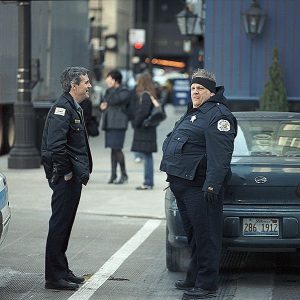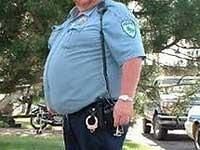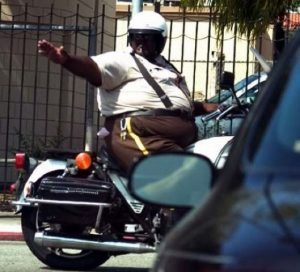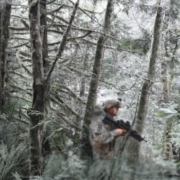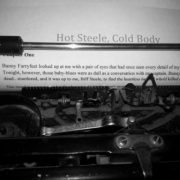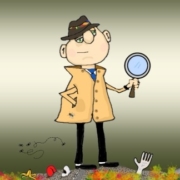Detectives v. Patrol: Point Your Tale In the Right Direction
Nearly all crime novels feature a muscle-bound, sharpshooting, fast-driving, marathon-running, cool-as-the-center-seed of-a-cucumber detective? What is it about the suit-wearing investigators that attracts a writer’s attention? After all, detectives are often the last officers to see any real action.
Police investigators are rarely in shootouts. They hardly ever chase fleeing suspects. In fact, their job is pretty mundane—see a body, collect some evidence, send evidence to a lab, talk to a few people, evidence results return from the lab in the morning mail, get a warrant, arrest the suspect (or have a uniform pick him up), testify in court, and then start all over again. Oh, and paperwork, paperwork, paperwork! Lots of mind-numbing paperwork.
Many detectives have been on the job for years and years, doing not much more than the above, and it’s this lack of activity that sometimes takes its toll in the form of flabby muscles, poor shooting skills, slow reaction times, couldn’t run if they wanted to (and they don’t), and yes, as more time passes by, even hot flashes, crappy eyesight and hearing, and bad backs, knees, and hips.
Writers are actually going about this thing all wrong. Bass-ackward, as some of the old-timers on my old beat used to say.
Patrol officers are the men and women who see all the excitement—going toe-to-toe with 350 lb. musclebound crooks who refuse to be handcuffed, shooting it out with armed robbers, 110 mph vehicle pursuits, chasing armed robbers through dark alleys, being bitten by dogs, removing unwanted 20-foot-long pythons from beneath mobile homes, rescuing people from burning cars and buildings, performing CPR on unconscious and unresponsive drug addicts, climbing in windows after burglary suspects, capturing prison escapees, wading into a street filled with drug dealers, gang members, and prostitutes, and rescuing tiny puppies and kittens from storm drains and frozen ponds. Now there’s the complete package—excitement and action along with a tender side. And who doesn’t love puppies and kittens, right?
So let’s explore this concept a bit further. Lots of people are attracted to fit men and women in uniform, right?
But how many people could possibly be attracted to detectives who wear rumpled, out-of-style suits and scruffy facial hair? For example …
Ridiculous to even consider, right?
Patrol officers hit the gym regularly so they can match muscle-for-muscle with the thugs they arrest on a daily basis. Detectives, well, they sometimes drive by a gym or two while on the way to their colorectal pre-surgery appointments.
Patrol officers hone their skills every single day. They’re out there in the trenches, staying sharp, looking sharp, and acting sharp.
Investigators start their day in their offices, drinking a cup of coffee while solving the daily crossword puzzle, using a pencil crudely sharpened with the pocketknives they carry for peeling apples and cutting loose threads from their suit jackets.
Uniformed officers are the front line officers, the “faces of the department.” Therefore, their hair is neatly trimmed, clothing neatly pressed, and shoes shined to glossy perfection.
Detectives are often seen wearing t-shirts, old jeans, and sneakers. And the last time they saw a set of hair clippers was the day they spent an entire morning grooming the family Lhasa Apso.
Patrol officers stare into the face of danger. Detectives work “undercover.”
Patrol officers fight crime. Detectives wait until the danger is over before “going in.”
Patrol officers rush into active crime scenes to save the victims. Detectives serve search warrants in the middle of the night, hoping to catch the bad guys while they’re sleeping.
So give this a little thought when you sit down to dream up a character for your next thriller. Do you go with bass-ackward tradition, or will your tale face a new direction?
Besides, who do you want saving your puppies, a super-fit, handsome patrol officer …
Or an out-of-shape, poorly-dressed detective who adores puppies, rainbows, and long walks on the beach at sunset?
*No puppies were harmed during the research portion of this article. I cannot say the same for donuts and chocolate cake.
*** A fantastic and unique opportunity! ***

As a bonus, USA Today & Wall Street Journal bestselling author Lisa Regan details how to use the elements of fiction to craft a gripping crime novel.
Sign up today to reserve your seat!
“Criminal Investigations: Writing Believable Make-Believe”
Schedule and Class order:
(All times are EST)
10:30 – Login and Test
10:45 – Welcome
11:00 – 12:20
Digital Breadcrumbs: Tracking People in Cyberspace ~ Instructor, Josh Moulin
Nearly every investigation involves some aspect of technology, whether it is used to commit the actual crime or contains evidence of criminal activity. In this information-packed session, you will learn how cybercrime investigators trace activity on the Internet, how mobile devices are tracked, how digital forensics is used to uncover evidence, and how law enforcement obtains information. Additionally, this course will cover techniques that suspects may use to try and hide their activity from law enforcement such as the darknet, anonymizing services, and anti-forensic tools.
12:20 – 12:50
Break
12:50 – 2:10
Sexual Assault: When a Victim Seeks Care in a Hospital Setting ~ Karmen Harris, RN, SANE-A
Based on a scenario, the class will explore what happens when a victim of sexual assault seeks care in a hospital setting. In this class, we will walk through the process of the medical-forensic exam and further explore how trauma is identified, the elements of documentation and forensic photography, evidence collection, and other aspects of the fascinating intersection of forensic science and nursing.
2:20 – 3:40
Using 3D Laser Scanners and Drones to Document Crime Scenes ~ Instructor, RJ Beam
3D scanners used by engineering firms have slowly been gaining traction in police work. Take a walk into a real homicide scene to see how the 3D reconstruction helped secure a conviction. Learn about how 3D scanners work and how drones can augment the creation of a 3D recreation.
3:50 – 5:10
Creating Dynamic Crime Fiction: How to use the elements of fiction to craft a gripping crime novel ~ Instructor, Lisa Regan
In this class you will learn how to combine several elements of fiction to create a crime novel that is authentic and riveting. You’ll learn tips and tricks for plotting effectively to keep readers turning pages. You’ll learn how to develop characters who are relatable and intriguing. We’ll discuss how to write believable dialogue that moves your story forward. You’ll also receive tips for incorporating information from law enforcement and other experts into you work. Finally, we will discuss advice on self-editing.
5:10
Final words



